The Crack
Intimate settings and deep character development break down the internal rationalizations that allowed the apartheid to last.
A literary study of domestic South Africa, The Crack mirrors the wider political situation of the Soweto uprising and makes powerful statements about apathy, complicity, and appearances.
During this tumultuous time, Janet Snyman’s policeman husband, Hector-Jans, takes a night job torturing black dissidents who object to the institution of apartheid. Meanwhile, Janet struggles to maintain order in their house as a yawning crack in her swimming pool threatens to destroy her home and her sanity. This is the story of apartheid’s effect on moderate white South Africans, sheltered people born into a system whose problems they implicitly understand but aren’t equipped to repair.
Like Janet Snyman’s swimming pool, the white veneer of South Africa is in the process of splitting, showing the world not only the oppressed and socially invisible black South Africans who support the nation, but also how the deep violence that is supposed to maintain the status quo actually destroys everyone who tacitly lives with it. Since it is coupled with the worsening of a historical social catastrophe, the book reads like a time bomb, becoming unbearably tense right up to the moment when everything falls apart.
The book focuses on Janet but gives Hector-Jans time, too, laying bare their internal processes and slow emotional crack-ups. As Janet struggles to hold together her marriage, her sanity, and her backyard, it becomes plausible that everything will be destroyed simply because she can’t survive outside of it. Her character is mirrored in Hector-Jans, who justifies his ugly duties with scripture. Together, they maintain the apartheid in broad daylight and in the dark, by gentle socioeconomic means and by violence, all for the sake of a doomed and misguided way of life.
The only truly evil character in their crumbling Garden of Eden is Doug, their snake-like neighbor. His advances to Janet spurned, he feeds Hector-Jans’s racist paranoia out of no identifiable motive except bloodlust. He is particularly satanic next to the saintly, self-sacrificing black servants, Alice and Solomon. Though the ending of the book is inevitably grim, Radmann’s strategic use of Solomon as a Christ figure implies the redemption that approaches with the end of apartheid.
Segregated South Africa is a complicated, surreal subject that defies explanation. Brave and intense, The Crack dares to challenge the idea that complicity is less dangerous than aggression.
Reviewed by
Anna Call
Disclosure: This article is not an endorsement, but a review. The publisher of this book provided free copies of the book to have their book reviewed by a professional reviewer. No fee was paid by the publisher for this review. Foreword Reviews only recommends books that we love. Foreword Magazine, Inc. is disclosing this in accordance with the Federal Trade Commission’s 16 CFR, Part 255.

